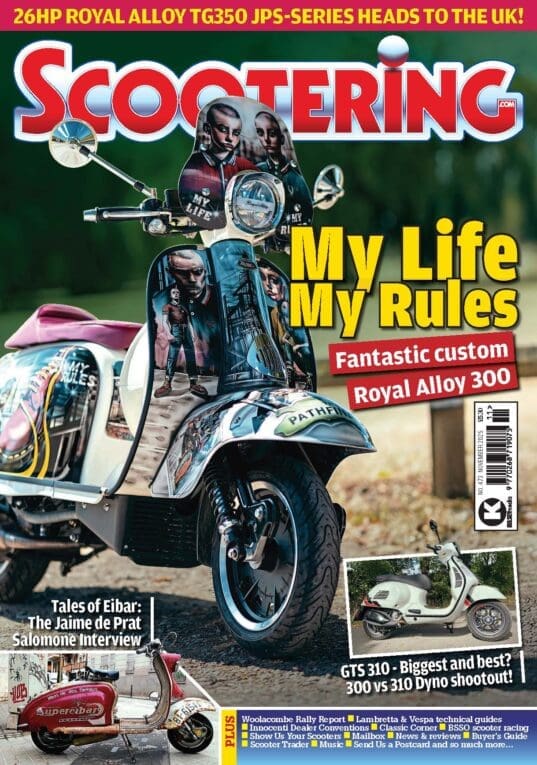Sometimes, an original design is so good that it can’t be bettered, but that doesn’t mean it shouldn’t be brought up to date…
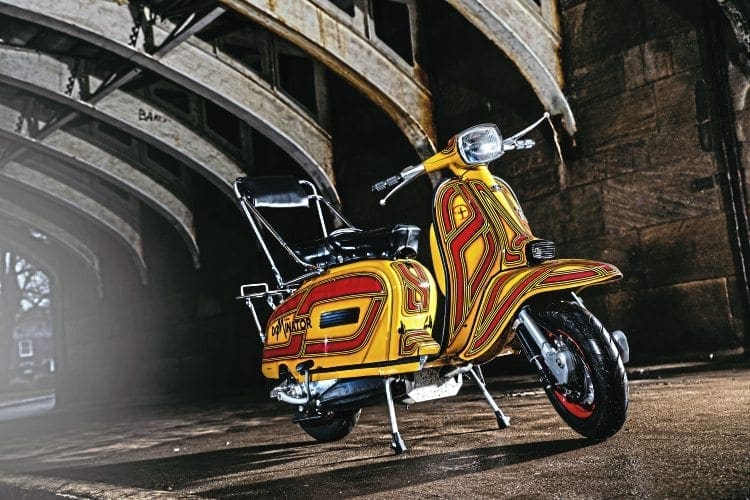
There’s been countless different paint schemes to adorn scooters over the years. Some are so iconic and well done that their legacy lives on. Certain periods in time not only produced classic designs but they still remain the most popular today. The explosion of custom scooters that were built after the post-1979 Mod revival into the early 1980s can definitely stake a claim to that accolade. Many were done by individuals who had their own vision of what they wanted to create but some were produced by dealers along with a specific theme. In Yorkshire, the most popular of course was the ‘S Type’ produced by AF Rayspeed but they didn’t have it all their own way.
York’s finest
There were many big scooter clubs based in ‘the north’ and none was any bigger than York SC. It reputedly boasted more than 100 active members, and many local business thrived off their custom. One of these was Reghams, based in York itself, which was an established meeting place for local scooterists. With the surge of scooter ownership at the time, Reghams produced its own dealer special. Known simply as the Dominator, it would feature a tuned engine and lavishly styled paint scheme.
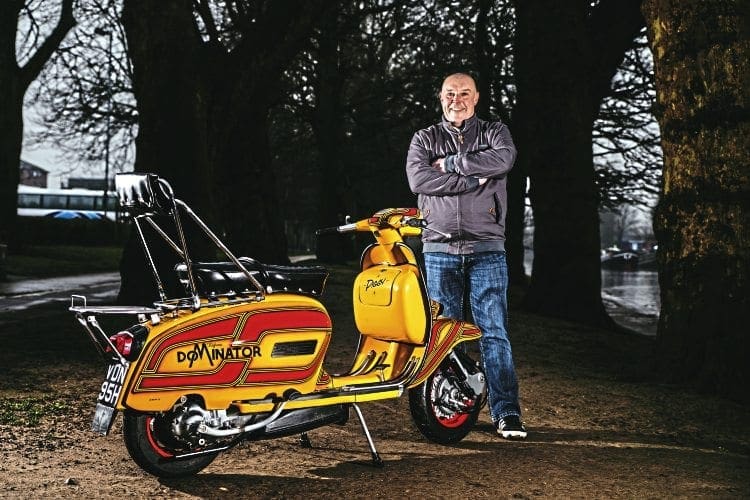
The paintwork for the Dominator was originally done by Maca at DTC who by now had already established himself as one of the leading painters on the custom circuit. Though it’s not sure how many of these machines Reghams actually built, Maca recalls painting at least six, four in yellow and two in blue. Painted between 1981 and 1983 there’s scarce evidence of any other surviving examples today and this is probably one of the reasons for them having such iconic status among the scootering fraternity.
Rolling back the years
Peter Pulleyn had started his scootering life just as the Reghams Dominator broke on to the scene. Having lived near the shop he was in awe of this stunning creation, though too young at the time to afford one. When an accident trashed his Grand Prix, however, he realised that now was the time to make his dream come true.
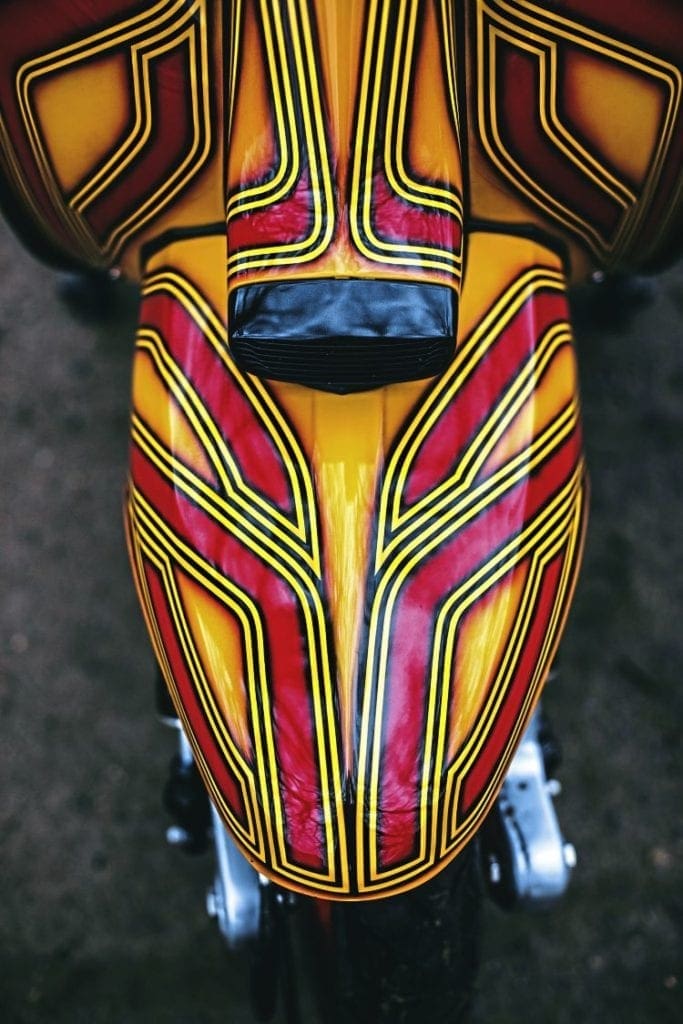
To his knowledge, no one had tried to reproduce a Dominator before. Though Reghams doesn’t exist any more… the painter does! Peter contacted Maca about painting a Lambretta in the Dominator scheme and without hesitation he was all too happy to oblige.
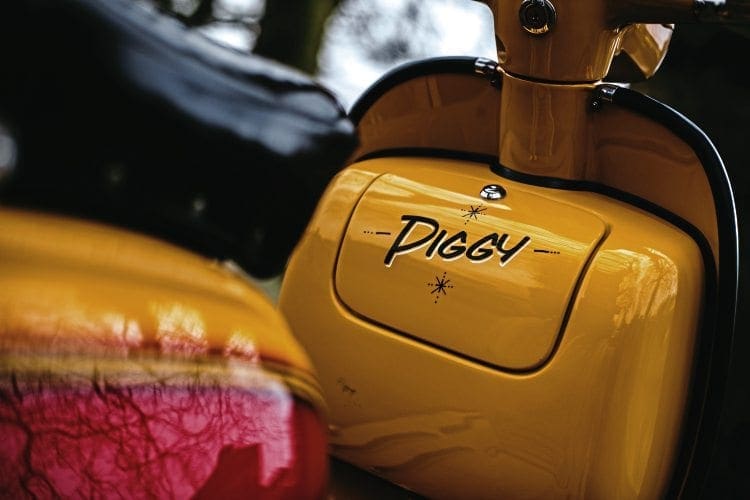
Knowing the exact layout of how the paint scheme needed to look meant he could virtually mirror image the original. Though the engine would use current Lambretta technology, Peter was keen to try and keep as near as possible an accurate reincarnation of how it was done back then.
Research
Though the Reghams Dominator is now regarded as a classic, it didn’t set the world on fire at the time it was produced. A few were sold, but it wasn’t widely publicised so not a great deal is known about it. Luckily for Peter, he does have memories of them at the time and several examples were sold locally to owners who are still within the scene. With the help of friend Jason Potter, who was instrumental in the engine building, he was able to track down a few images of original examples. This would help to a certain extent but by also using Maca there was enough knowledge between them to get it exactly right.
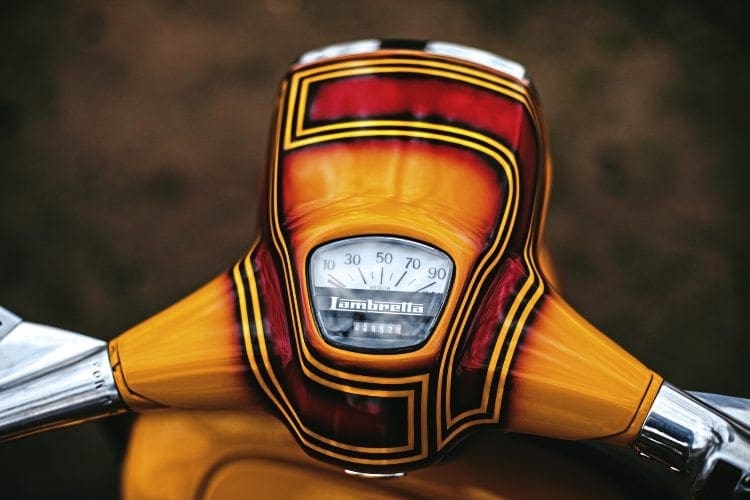
Peter opted for the yellow, red and black scheme which was the most popular at the time. The design, though classic 1980s, has a modern look to it and doesn’t look out of place almost 40 years on. The yellow base background, allows the red stripes to stand out as they intertwine with each other. Though it is quite a complicated design, it does work well. The side panels are a little more subtle and the sweeping lines flow much easier on the long flat surface of the GP profile. Maca has again delivered a classic, with an outstanding quality of workmanship.
Castaway
At the time the Dominator’s were produced only cast barrel tuning was available and the preferred choice of exhaust was the clubman. Though it’s still possible to do it this way, modern fuels don’t work quite so well — certainly with cooling — so it was decided to take up the option of an 225 RT kit instead, with a little porting. A GP200 gearbox, bigger sprockets, a 28mm Dellorto and BGM exhaust combine to give smooth performance. Who knows, if Reghams were building one today then perhaps that’s the route they would have gone down regarding what was actually inside the engine?
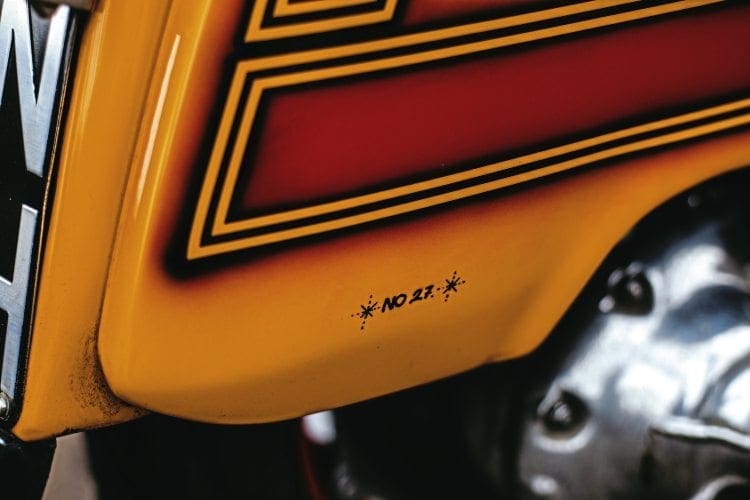
At the front, there is very little in the way of fancy upgraded brakes. The original Dominator was based on the Indian GP and so came fitted with a traditional drum brake. Peter has done the same but with the reverse pull system. Though not the best regarding stopping power if set up right the reverse pull drum brake works better than you think. Even so, front dampers are still a necessity and a pair BGM ones cope more than admirably with the task of preventing the front end from dipping violently, a common trait of the reverse pull drum brake system.

As for the rest then it’s all very 1980s from the standard 90mph speedometer to the GP coffin seat. Another thing this Lambretta lacks is chrome. The original didn’t have it so possibly it would look out of place on a recreation was Peter’s thinking. There is a leg shield toolbox fitted for extra spares etc. and Peter’s nickname of Piggy is present. Though this is a modern addition not seen on the original it is not out of place and helps take up the void space that is always a problem area with Lambretta customisation. At the back is a flip-flop or Bradford backrest as they are known which is synonymous with the 1980s scooter scene and looks the perfect accompaniment. A small rear mounted rack behind finishes the job off nicely and is essential for luggage when touring. That’s about all apart from a long range tank which these days is an essential part of the equipment on a modern Lambretta.
Doing it justice
What Peter has created is a beautiful 1980s looking Lambretta paying homage to a classic from that era. All too often it is easy to overlook what you are trying to achieve when building a replica from days gone by. Back then they used what was available to them, whether it was in the engine or on the chassis.
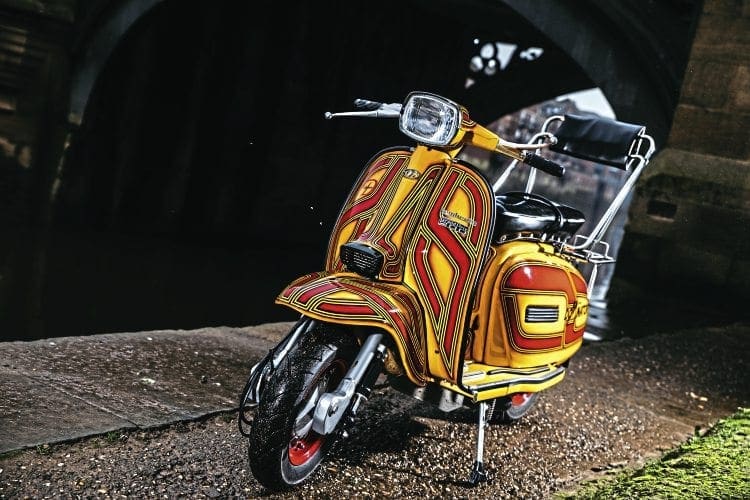
Now with advances in production just about every Lambretta part ever made has been bettered one way or another. This has meant it’s easy to go way over the top and lose track of exactly what you’re trying to achieve in the first place.
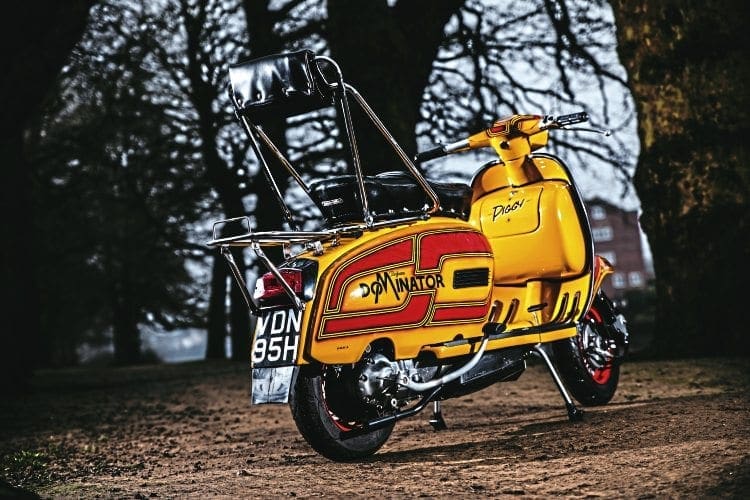
Yes, Peter has used modern parts in the engine and who can blame him? It’s alright doing an exact replica of what was originally done but if you are using it on a daily basis some sort of practicality needs to be built in.
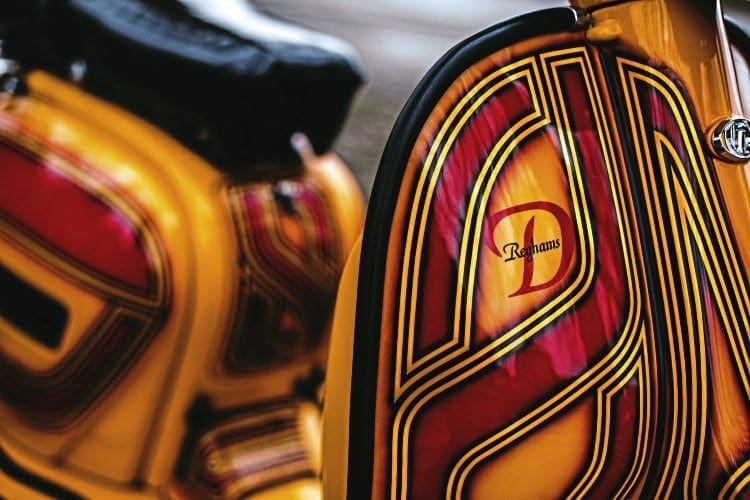
By not being too radical with the engine or anything else for that matter perhaps what he has done is correct. If it was an original Dominator from the time and still on the road with what needed then maybe this is how it would exactly be now. I’m pretty sure people reading about what Peter has done or those that see it out on the open road will be spurred on to do the same with their next build. As we all get further and further immersed in scooter nostalgia there will no doubt be many other recreations of classic designs from days gone by. For now though, we can all admire this one as it sets the perfect example of how it should be done.
OWNER DETAILS
Name: Pete Pulleyn (Piggy)
Job: Postman.
Scooter club & town: Northern SC Leeds but live in York.
How and when did you first become interested in scooters: Just caught the back end of the mod/2-Tone era in the early 80s and always wanted a scooter.
First scooter: Vespa PK80.
Favourite scooter model: Series 2.
Favourite style of custom scooter: 80s style street racers.
First rally or event: Scarborough 1986.
How did you get there: Vespa.
Any stories: There was a lot of stealing going on, somebody nicked my my headset top!
Favourite event: Love Cleethorpes.
Funniest experience with a scooter: Going to Morecambe ’87-ish, two-up on my Vespa and not being able to get up a hill! My mate had to get off and walk only to be greeted by a layby full of cheering scooterists! Some of whom I knew! Took some stick that weekend!
Furthest you’ve ever ridden on a scooter: Great Yarmouth in the late 80s.
What do you like about rallies: The fact that you see people you haven’t seen for years and it’s like you saw them yesterday.
What’s your favourite Scootering magazine feature: Show Us Your Scoots.
Your favourite custom scooter of all time: Always loved Sign of the Snake.
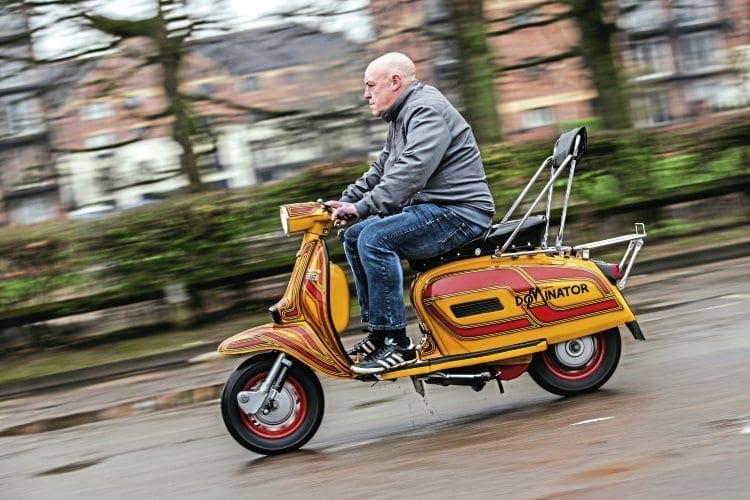
SCOOTER DETAILS
Name of scooter and reason: Dominator. When we were teenagers growing up in late 70s/early 80s, Reghams local Lambretta dealer came up with these bikes and I always wanted one. When I smashed my GP up I thought nobody have ever reproduced one, so I got in touch with Maca who sprayed them originally and this is the result. Well chuffed!
Scooter model: GP 200.
Date purchased and cost: Bought in 2005 off Stu Thurston (The Emporor) who’d done a lovey paint job on it for me. Cost about £3500.
Inspiration for project: Going back to my youth and the amount of time we used to spend in Reghams.
Time to build & by who: Just over a year. Built by my mate Jase Potter and sprayed by Maca.
Any specialised parts or frame mod: Original seat, original 80s flipover backrest and Series 2 clutch lever.
Engine spec: Kit: RT225. Crank: 58 x 110. Carb: 28mm Dellorto. Exhaust: BGM Clubman. Clutch: Updated standard. Gearbox: GP200 with 19/46 sprockets. Porting work by: Porting work done by Jase Potter. Dyno done by: Dyno done by Chisel Speed.
Describe engine performance, power delivery and scooter handling: Very responsive and crisp. A bit slower with a big lad like me on!
Are there any other unique details we have missed: Had to put Piggy on the toolbox as I’ve always been known as that since I started rallying.
Top & cruising speed: 70mph top, and 60mph cruising.
Paintwork & murals done by: The brillaint Maca at DTC.
What was the hardest part of the project: Tracking down old photos of Dominators as there weren’t many done.
In hindsight, is there anything you would have done differently: Nothing I would have done differently, it’s all gone fairly smoothly.
Is there anyone you wish to thank: Jase Potter for all the mechanics and research he’s done. Maca for the brilliant paintwork. Dan Guest for his help with the research and finally my fiancee Vicky for putting up with me while we’ve been doing it.
Words: Stu Owen
Photographs: Gary Chapman

